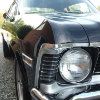I was reading about sanding between clear coats. Like spray on 3 coats, let dry, then block sand with 600 and spray on a couple more. Then cut and buff.
My question is about sanding scratches. Are the scratches the same if sanded wet or dry?
Danford1
Sanding between clear coats, 600 wet or 600 dry?
17 posts
• Page 1 of 2 • 1, 2
|
We do 800 wet at work. Works for us, no sand scratches visable
|
|
|
What's the advantage of sanding between clear coats?
Seems like a lot of work for minimal benefit.....? "If you can't move it, paint it." - U.S. Army
|
|
|
Fully Engaged
Posts: 128
Joined: Sat Jun 15, 2013 10:17 pm Country: Canada |
That's what I was thinking. Sand the final coat, buff and call it a day |
|
Just curious as to why you are even considering sanding between coats of clear? Are you painting in an area with a lot of dust/dirt in the air? Maybe try to fix that issue, instead...
|
|
Are you referring to a "flow coat" that is often done on show cars? As for scratches being the same when wet or dry sanding the answer is yes. The grit size is what makes the scratches. The main advantage to wet sanding is that it keeps the sandpaper from loading up. A few drops of dish soap are added to the water to provide lubrication. Another advantage is that rinsing often with water while wet sanding reduces the chance of a piece of dirt being lodged in the dust under the paper and putting a deep scratch in the surface. 1968 Coronet R/T
ACTS 16:31 |
|
|
I know a lot of guys who do show cars and none of them sand between clear, so I still don't get it. Bentley and and Aston Martin cut and buff every single car off their line, by hand -- and they don't sand then apply more clear, either.
Is there actually a technical reason why this helps? Clear on clear ends up being monolithic so I can't see how final cut/buff "knows" if it is being done on a 2 mil film build or a 6 mil build. |
|
|
Weird.... This used to be a very common topic on this board and many others.
JCCLARK, Bondoking, BarryK from **********, JimC, and a few others used to talk about it all the time.  Do a search with "flow coat" in quotes and it will return many pages of threads regarding flow coating. There are 2 main reasons for flow coats: Reducing the amount of urethane wave and the amount orange peel on the final coats. Urethane wave is a whole 'nother subject that has much debate, but it comes down to a warping effect that you can see when sighting down a panel while changing your perspective. I prefer to wet sand on the final stages, unless its just small denibbing or a cowl panel that I don't want to get water inside. Wet sanding will generally cut material much faster than dry sanding. As mentioned above, it also keeps your paper cleaner and makes it last longer. |
|
|
The idea is to shoot 3 coats of clear and block sand with 400 - 600 (depending on your confidence level I imagine) to flatten the surface removing any urethane wave and orange peel present.
Shoot a couple of more coats of clear using a slower activator and reducer. This will flow out nearly perfect and take minimal work to cut and buff. The difference as pointed out by VWBobby is a sharp clear reflection that doesn't distort as you view from different angles. Many paint jobs look great straight on but as you walk the car and look back at an angle you start to see some "movement." Admittedly it takes a trained eye to spot it but once you've seen it you seem to see it more rapidly. I would think it only worth the effort on high end restorations, customs and trailer queen show cars. Personally, I have found if I do my first round of wet sanding with a hard block (I use a piece of Oak) that it flattens well enough to produce the same effect when buffed. There is another technique that I hope to try soon that is supposed to leave your clear looking as if you dipped it. It will be a while before I get to try it though. Will keep you posted. 1968 Coronet R/T
ACTS 16:31 |
|
Don't tease us....  
"If you can't move it, paint it." - U.S. Army
|
|
17 posts
• Page 1 of 2 • 1, 2
Who is online
Users browsing this forum: No registered users and 303 guests
